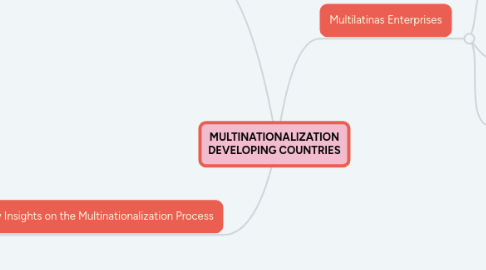
1. Internationalization Process of Multilatinas
1.1. Multinationalization start
1.1.1. Consequence of different changing aspects, such as specific economic instability conditions and structural reform.
1.1.1.1. Once the multilatinas were more competitive and highly succesful in their origin countries, they proceeded to an FDI.
1.2. Location to start multinationalization
1.2.1. Enterprises tend to begin their process in physical nearby countries in order to minimize risks of culture and different type of markets.
1.2.1.1. By reducing risk they can enter in a more efficient way to similar marketswithout taking high risks.
1.2.2. Companies will start by countries with benefit advantage or location.
1.2.2.1. This, is based on the similarity on certain industries such as food industry that go to other country to get the same agricultural products but in a non-expoited market.
2. New Insights on the Multinationalization Process
2.1. The average of time that companies sdtudied took to become a multilatina is about 49 years. This happenend when the market and the countrie of origin has a serie of changes that promoted the company to look for external markets tha could be profitable.
2.1.1. The closed markets in the late C. XX was a big challenge at the time to FDI, by the time, lots of enterprises made exports to other markets but there were a big difference between exporting and FDI into an unknown market.
2.2. Four strategies in the multinationalization process in terms of where to start this.
2.2.1. 1. Start in countries that have similar culture and development, this ensures an easier way to operate from the multilatina.
2.2.2. 2. Choose a country that has distant culture and development, this is based on the higher development of the countries to take advantage of the complementary and when the resources and knoweledge can be easily transferred.
2.2.3. 3. When the countries are culturally proximate and distant in development, this takes place due to the preference of certain cultures and products of some cultures independent on the development but taking more into account the proximity of cultures.
2.2.4. 4. Proximity in development but distance of culture, this happens when the interest in the company is linked to the specific knoweledge that can be shared and complementary resources that companies can find rather than in culture similarity.

